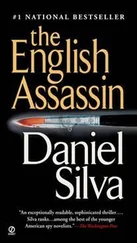He emerged from the George V stop at his usual time, 11:40, and started up the Avenue des Champs-Élysées. Those lucky enough to survive the inferno to come would later say there was nothing unusual in his appearance, though the owner of a popular flower shop claimed to notice a curious determination in his gait as he closed in on the entrance of the restaurant. Among those standing outside were a deputy minister of justice, a newsreader from French television, a fashion model currently gracing the cover of Vogue magazine, a Gypsy beggar clutching the hand of a small child, and a noisy group of Japanese tourists. The bomber made one final check of his watch. Then he unzipped his coat.
It was never clearly established whether the act was preceded by the traditional scream of “Allahu Akbar.” Several survivors claimed to have heard it; several others swore the bomber detonated his device in silence. As for the sound of the explosion itself, those closest had no memory of it at all, for their eardrums were too badly damaged. To a person, all recalled seeing a blinding white flash of light. It was the light of death, said one. The light one sees at the moment he confronts God for the first time.
The bomb itself was a marvel of design and construction. It was not the kind of device built from Internet manuals or the how-to pamphlets floating around the Salafist mosques of Europe. It had been perfected under battle conditions in Palestine and Mesopotamia. Packed with nails soaked in rat poison—a practice borrowed from the suicide bombers of Hamas—it carved through the crowd like a circular saw. So powerful was the explosion that the Louvre Pyramid, located a mile and a half to the east, shivered with the blast wave. Those closest to the bomber were blown to pieces, sheared in half, or decapitated, the preferred punishment for unbelievers. Even at forty paces, limbs were lost. At the farthest edge of the kill zone, the dead appeared pristine. Spared outward trauma, they had been killed by the shock wave, which ravaged their internal organs like a tsunami. Providence had granted them the tender mercy of bleeding to death in private.
The first gendarmes to arrive were instantly sickened by what they saw. Extremities littered the paving stones, along with shoes, smashed wristwatches frozen at 11:46, and mobile phones that rang unanswered. In one final insult, the murderer’s remains were scattered among his victims—everything but the head, which came to rest on a delivery truck more than a hundred feet away, the bomber’s expression oddly serene.
The French interior minister arrived within ten minutes of the explosion. Seeing the carnage, he declared, “Baghdad has come to Paris.” Seventeen minutes later, it came to the Tivoli Gardens in Copenhagen, where, at 12:03 p.m., a second suicide bomber detonated himself amid a large group of children waiting impatiently to board the park’s roller coaster. The Danish security service, the PET, quickly established that the shahid had been born in Copenhagen, had attended Danish schools, and was married to a Danish woman. It seemed not to trouble him that his own children attended the same school as his victims.
For the security professionals across Europe it was the nightmare scenario come true—coordinated and highly sophisticated attacks that appeared to have been planned and executed by a skilled mastermind. They feared the terrorists would strike again soon, though two critical pieces of information eluded them. They did not know where. And they did not know when.
Chapter 3
St. James’s, London
LATER, THE COUNTERTERRORISM COMMAND OF London’s Metropolitan Police Service would expend much valuable time and effort trying to reconstruct the movements that morning of one Gabriel Allon, the legendary but wayward son of Israeli intelligence, now formally retired and living quietly in the United Kingdom. It is known, based on eyewitness accounts from his meddlesome neighbors, that he departed his cottage in Cornwall a few minutes after dawn and climbed into his Range Rover, accompanied by his beautiful Italian-born wife, Chiara. It is also known, due to Britain’s Orwellian system of CCTV cameras, that the couple reached central London in near-record time, and that, through an act of divine intervention, they managed to find a somewhat legal parking space in Piccadilly. From there they proceeded on foot to Mason’s Yard, a tranquil quadrangle of paving stones and commerce in St. James’s, and presented themselves at the door of Isherwood Fine Arts. According to the CCTV camera in the yard, they were admitted into the premises at 11:40 London time, though Maggie, Isherwood’s latest mediocre secretary, would erroneously record the time in her logbook as 11:45.
Purveyors of museum-quality Italian and Dutch Old Master paintings since 1968, the gallery had once occupied a lofty perch on tony New Bond Street in Mayfair. Driven into St. Jamesian exile by the likes of Hermès, Burberry, and Cartier, it had taken refuge in three floors of a sagging warehouse once owned by Fortnum & Mason. Among the incestuous, backbiting villagers of St. James’s, the gallery had always been regarded as rather good theater—comedy and tragedy, stunning highs and seemingly bottomless lows, and always a whiff of conspiracy lying just beneath the surface. This was, in large measure, a consequence of the owner’s personality. Julian Isherwood was cursed with a near fatal flaw for an art dealer—he liked to possess art more than he liked to sell it. As a result, he was burdened with a large inventory of what is affectionately known in the trade as dead stock—paintings for which no buyer would ever pay a fair price. It was rumored that Isherwood’s personal holdings rivaled those of the British royal family. Even Gabriel, who had restored paintings for the gallery for more than thirty years, had only the vaguest idea of Isherwood’s true holdings.
They found him in his office—a tall, slightly precarious figure tilted against the front of a desk piled with old catalogs and monographs. He wore a gray chalk-stripe suit and a lavender necktie that had been given to him the previous evening by his latest love interest. As usual, he appeared slightly hungover, a look he cultivated. His eyes were fixed mournfully on the television.
“I take it you’ve heard the news?”
Gabriel nodded slowly. He and Chiara had heard the first bulletins on the radio as they were passing through the western suburbs of London. The images playing out on the screen were remarkably similar to the ones that had formed in Gabriel’s own mind—the dead covered in plastic sheeting, the bloodied survivors, the onlookers with their palms pressed to their faces in horror. It never changed. He supposed it never would.
“I had lunch at Fouquet’s last week with a client,” Isherwood said, running a hand through his longish gray locks. “We parted company on the very spot where that maniac detonated his bomb. What if the client had scheduled the lunch for today? I might have been—”
Isherwood stopped himself. It was a typical reaction after an attack, thought Gabriel. The living always sought to find some connection, however tenuous, to the dead.
“The bomber in Copenhagen killed children,” Isherwood said. “Will you please explain to me what cause is served by the murder of innocent children?”
“Fear,” said Gabriel. “They want us to be afraid.”
“When is this going to end?” Isherwood asked, shaking his head in disgust. “When in God’s name is this madness going to end?”
“You should know better than to ask a question like that, Julian.” Gabriel lowered his voice and added, “After all, you’ve had a ringside seat at this war for a very long time.”
Isherwood gave a melancholy smile. His backbone-of-England surname and English scale concealed the fact that he was not, at least technically, English at all. British by nationality and passport, yes, but German by birth, French by upbringing, and Jewish by religion. Only a handful of trusted friends knew that Isherwood had staggered into London as a child refugee in 1942 after being carried across the snowbound Pyrenees by a pair of Basque shepherds. Or that his father, the renowned Paris art dealer Samuel Isakowitz, had been murdered at the Sobibor death camp along with Isherwood’s mother. Though Isherwood had carefully guarded the secrets of his past, the story of his dramatic escape from Nazi-occupied Europe had reached the ears of Israel’s secret intelligence service. And in the mid-1970s, during a wave of Palestinian terrorist attacks against Israeli targets in Europe, he was recruited as a sayan , a volunteer helper. Isherwood had but one assignment—to assist in building and maintaining the operational cover of an art restorer and assassin named Gabriel Allon.
Читать дальше
Конец ознакомительного отрывка
Купить книгу












